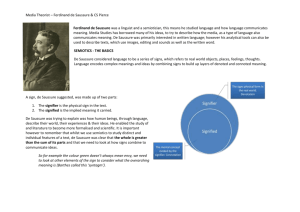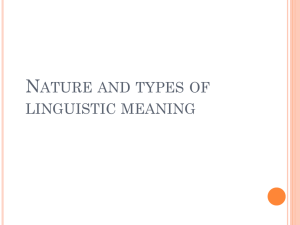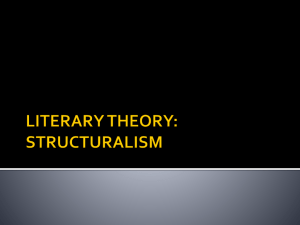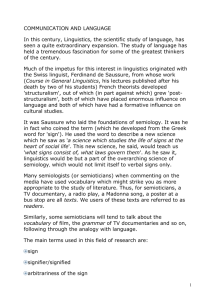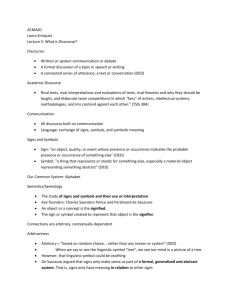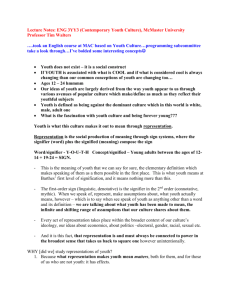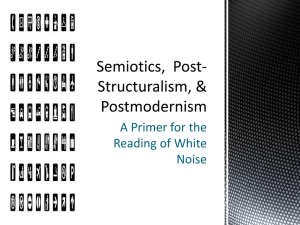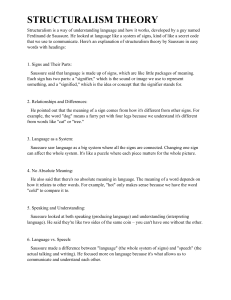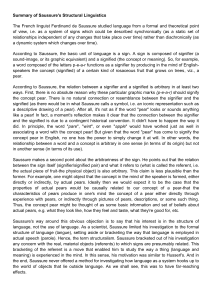Of Grammatology (Selection): Notes
advertisement
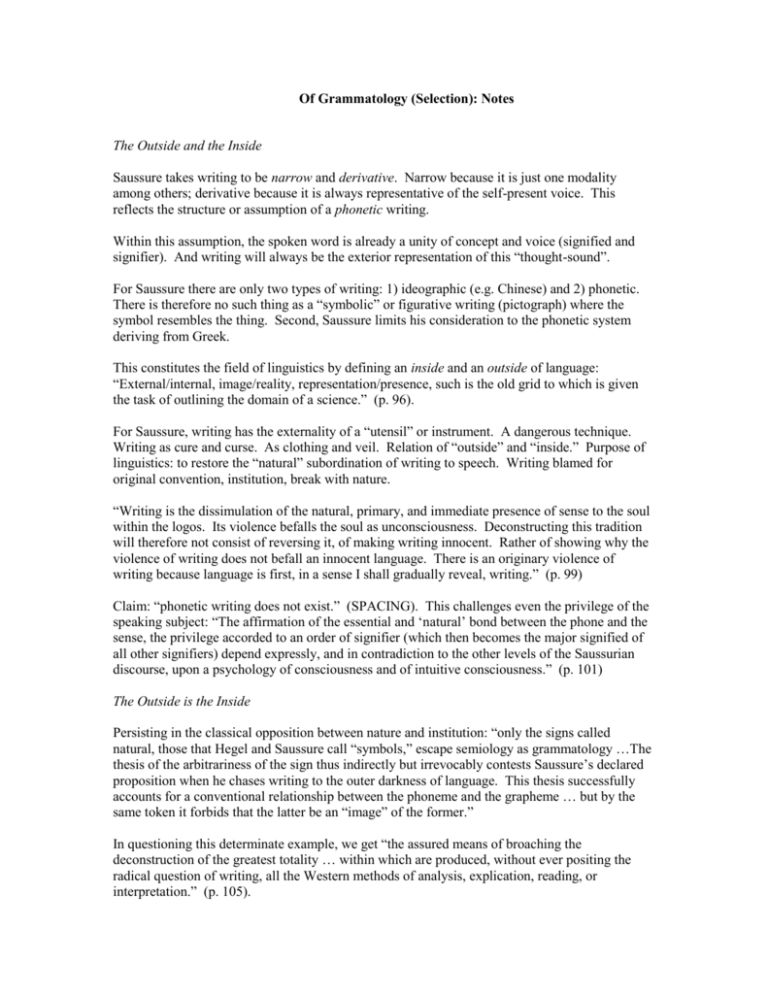
Of Grammatology (Selection): Notes The Outside and the Inside Saussure takes writing to be narrow and derivative. Narrow because it is just one modality among others; derivative because it is always representative of the self-present voice. This reflects the structure or assumption of a phonetic writing. Within this assumption, the spoken word is already a unity of concept and voice (signified and signifier). And writing will always be the exterior representation of this “thought-sound”. For Saussure there are only two types of writing: 1) ideographic (e.g. Chinese) and 2) phonetic. There is therefore no such thing as a “symbolic” or figurative writing (pictograph) where the symbol resembles the thing. Second, Saussure limits his consideration to the phonetic system deriving from Greek. This constitutes the field of linguistics by defining an inside and an outside of language: “External/internal, image/reality, representation/presence, such is the old grid to which is given the task of outlining the domain of a science.” (p. 96). For Saussure, writing has the externality of a “utensil” or instrument. A dangerous technique. Writing as cure and curse. As clothing and veil. Relation of “outside” and “inside.” Purpose of linguistics: to restore the “natural” subordination of writing to speech. Writing blamed for original convention, institution, break with nature. “Writing is the dissimulation of the natural, primary, and immediate presence of sense to the soul within the logos. Its violence befalls the soul as unconsciousness. Deconstructing this tradition will therefore not consist of reversing it, of making writing innocent. Rather of showing why the violence of writing does not befall an innocent language. There is an originary violence of writing because language is first, in a sense I shall gradually reveal, writing.” (p. 99) Claim: “phonetic writing does not exist.” (SPACING). This challenges even the privilege of the speaking subject: “The affirmation of the essential and ‘natural’ bond between the phone and the sense, the privilege accorded to an order of signifier (which then becomes the major signified of all other signifiers) depend expressly, and in contradiction to the other levels of the Saussurian discourse, upon a psychology of consciousness and of intuitive consciousness.” (p. 101) The Outside is the Inside Persisting in the classical opposition between nature and institution: “only the signs called natural, those that Hegel and Saussure call “symbols,” escape semiology as grammatology …The thesis of the arbitrariness of the sign thus indirectly but irrevocably contests Saussure’s declared proposition when he chases writing to the outer darkness of language. This thesis successfully accounts for a conventional relationship between the phoneme and the grapheme … but by the same token it forbids that the latter be an “image” of the former.” In questioning this determinate example, we get “the assured means of broaching the deconstruction of the greatest totality … within which are produced, without ever positing the radical question of writing, all the Western methods of analysis, explication, reading, or interpretation.” (p. 105). The instituted trace. A retention of difference, in which difference appears as such. The trace “requires a synthesis in which the completely other is announced as such.” (p. 106). The trace “produces itself as self-occultation.” “Thus, as it goes without saying, the trace whereof I speak is not more natural (it is not the mark, the natural sign, or the index in the Husserlian sense) than cultural, not more physical than psychic, biological than spiritual. It is that starting from which a becoming-unmotivated of the sign, and with it all the ulterior oppositions between physis and its other, is possible.” (p. 106). Movement along the signifying chain of differences as play: “From the moment that there is meaning there are nothing but signs. We think only in signs. Which amounts to ruining the notion of the sign at the very moment when, as in Nietzsche, its exigency is recognized in the absoluteness of its right. One could call play the absence of the transcendental signified as limitlessness of play, that is to say as the destruction of ontotheology and the metaphysics of presence.” (p. 108) Difference as the source of linguistic value (for Saussure). Difference as what can never appear as “ a sensible plenitude.” Saussure’s thesis problematized by the assumption of language as a system of differences. “I believe that a generalized writing is not just the idea of a system to be invented, a hypothetical characteristic or a future possibility. I think on the contrary that oral language already belongs to this writing. But that presupposes a modification of the concept of writing that we for the moment merely anticipate.” (p. 112). Toward an arche-writing that differs from and communicates with the vulgar concept of writing. Writing and “Experience.”: “ ‘Experience’ has always designated the relationship with a presence, whether that relationship had the form of consciousness or not. At any rate, we must … exhaust the resources of the concept of experience before attaining and in order to attain, by deconstruction, its ultimate foundation.” (p. 116). We have to go through the concept of the arche-trace. “The pure trace is differance. It does not depend on any sensible plenitude, audile or visible, phonic or graphic. It is, on the contrary, the condition for such a plenitude. Although it does not exist, although it is never a being-present outside of all plenitude, its possibility is by rights anterior to all that one calls sign (signified/signifier, content/expression, etc.), concept or operation, motor or sensory. This differance is therefore not more sensible than intelligible and it permits the articulation of signs among themselves within the same abstract order … It permits the articulation of speech and writing … as it founds the metaphysical opposition between the sensible and the intelligible, then between signifier and signified, expression and content, etc.” (p. 117) “The trace is in fact the absolute origin of sense in general. Which amounts to saying once again that there is no absolute origin of sense in general. The trace is the differance which opens appearance and signification.” (p. 119)

